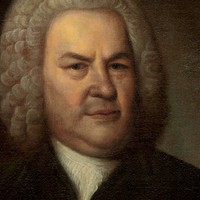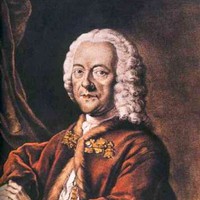Richard Egarr Plays Bach

Sponsored By
- October 18, 2019


Sponsored By

 Listen to Audio
Listen to Audio
From 1723 until his death in 1750, Johann Sebastian Bach held the demanding position of Thomaskantor, directing music for the principal churches of Leipzig and training the young choristers under his care. Somehow Bach also found the time to direct the Collegium Musicum, an amateur ensemble founded by Georg Philipp Telemann back when he was a student in Leipzig. With most concerts held at a coffee house, the Collegium Musicum provided Bach a space where he could present secular music not fit for church, including the four surviving Orchestral Suites inspired by French dance music.
Bach probably composed the Orchestral Suite No. 1 during his early years in Leipzig, perhaps in 1725. Suites in the French style had become fashionable in Germany, where such a work would have been described as an Ouverture (to use the French spelling), taking the name from the substantial opening movement. As was customary, this one begins with slow dotted rhythms that establish an air of gravitas, linked to a fast fugal section.
The dances that constitute the remainder of the suite each adopt the usual binary structure, consisting of two repeated sections. All but the Courante and Forlane come in sets of linked pairs organized in a da capo format, meaning that the first dance returns for a final pass after the second concludes. In the Forlane — the only movement with that title in Bach’s surviving output — the pastoral oboe melody, droning bass and slurred accompaniment make for a memorable effect. Instead of ending with a typical gigue, the suite closes with a pair of Passepieds, another rare form found only four times in Bach’s music. This fast spin on a minuet reuses the same melody for the second part, dropping the tune to a lower octave and adding a dizzying counter-line from the oboes.
Aaron Grad ©2024

Under the banner of Tafelmusik or “table music” — meaning the kind of music fit to entertain guests while dining — Telemann collected three “productions” that each combined orchestral suites, concertos and chamber music into a readymade dinner party playlist. This ambitious publication from 1733 was another example of how Telemann capitalized on his international reputation to bolster his church salary, attracting subscribers from Germany and beyond who pre-ordered this Musique de table, as its original title page labeled it.
Telemann’s musical approach was as international as his appeal. In true French style, each production of Tafelmusik begins with an Overture, and the first one in E minor is a quintessential model of the form, with slow outer sections surrounding a fast, fugal episode. In that time, the term Overture encompassed not just the large opening movement, but also the shorter dance forms that followed it, including a particularly festive number in this suite labeled Rejouissance, or “rejoicing” (a heading that Handel recycled 16 years later in his Music for the Royal Fireworks).
Aaron Grad ©2019

It was not unusual for eighteenth-century musicians to hold a variety of professional appointments. Georg Philipp Telemann, however, had an even more multi-faceted career than most of his contemporaries. In addition to composing an astonishing 3000 pieces, Telemann also worked as a church music director, opera director, orchestra concertmaster, court music director, and university ensemble director. In fact, Telemann was so famous that he was the Leipzig authorities’ first choice for the coveted position of music director for the Thomaskirche in 1723. Only when Telemann, and subsequently Johann Christoph Graupner, turned down the job did the search committee hire their third choice — Johann Sebastian Bach.
Unlike many other eighteenth-century composers, Telemann was not born into a musical family, and he had little musical training before high school. When he began composing, his mother was concerned that music would be an unsuitable professional path, and she forbid him from playing or writing music. Telemann disobeyed her wishes, and his mother sent him to boarding school as a punishment. Being away from home gave Telemann ample opportunities to continue his musical education, and he learned to play the violin, organ, harpsichord, chalumeau, viola da gamba and bass trombone.
As a twenty-year-old student, Telemann vowed to give up music and study law at the University of Leipzig. His university roommate, however, discovered the score to one of Telemann’s settings of Psalm 6 in a suitcase and arranged to have the piece performed in Leipzig’s Thomaskirche and Nikolaikirche. The city mayor was so impressed with the piece that he commissioned Telemann to compose music every other week for the churches, even though the city already had a music director. Telemann subsequently withdrew from law school and launched his extraordinary career as a professional musician.
Telemann’s Quartet in A Minor likely dates to the 1720s and is considered to be one of his finest quartets. The piece opens with a poignant movement full of unrelenting sighing figures over a heart-beat-like pulsing bass line. Small melodic motives are passed seamlessly between the upper three instruments. This is followed by an impressive intellectual contrapuntal feat — a movement that is structured as a triple fugue. Nowhere else in his quartets does Telemann write a movement with counterpoint that is this complex. A fugue typically has a single musical subject (motive) that is then sounded in imitation between the parts. In this movement, there are three individual musical subjects, which eventually sound simultaneously without breaking any of the strict rules of eighteenth-century counterpoint.
In the mellow third movement, a single melodic motive is stated in close imitation between the three upper voices. This is followed by a fourth movement written in the Sonate auf Concertenart genre that Telemann is credited with codifying. In this genre, elements of the sonata and concerto are blended, and whether an instrument is functioning as a soloist or accompanist is often intentionally unclear. The solo passages are particularly virtuosic in this final triumphant movement.
Paula Maust ©2022

Bach ended up directing Leipzig’s Collegium Musicum from 1729 to 1741, and to generate enough repertoire for the weekly concerts, he mined his catalog of pre-Leipzig instrumental music. His decision to rework at least six old concertos for various instruments into harpsichord concertos reflected recent advances in instrumental design that made the keyboard instrument louder than ever, and it also allowed him to showcase some of the ensemble’s most talented members: his own sons. The forerunner of the Harpsichord Concerto No. 1 is lost, but it seems clear that the solo part originated on the violin, based on the patterns of repeated notes that correspond to the violin’s open strings.
Aaron Grad ©2019
Can't attend any of these performances? Join us for an open rehearsal on Thursday, October 17 at 2:30pm
Get driving directions and find nearby parking.
Find dining options close to the venue.
View seating charts to find out where you'll be seating.
Get driving directions and find nearby parking.
Find dining options close to the venue.
View seating charts to find out where you'll be seating.
